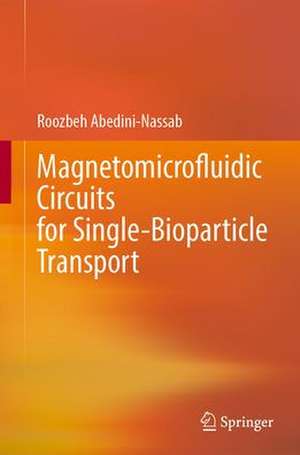Magnetomicrofluidic Circuits for Single-Bioparticle Transport
Autor Roozbeh Abedini-Nassaben Limba Engleză Hardback – 26 apr 2023
| Toate formatele și edițiile | Preț | Express |
|---|---|---|
| Paperback (1) | 725.19 lei 38-45 zile | |
| Springer Nature Singapore – 27 apr 2024 | 725.19 lei 38-45 zile | |
| Hardback (1) | 891.33 lei 6-8 săpt. | |
| Springer Nature Singapore – 26 apr 2023 | 891.33 lei 6-8 săpt. |
Preț: 891.33 lei
Preț vechi: 1086.99 lei
-18% Nou
Puncte Express: 1337
Preț estimativ în valută:
170.56€ • 182.38$ • 142.21£
170.56€ • 182.38$ • 142.21£
Carte tipărită la comandă
Livrare economică 18 aprilie-02 mai
Preluare comenzi: 021 569.72.76
Specificații
ISBN-13: 9789819917013
ISBN-10: 9819917018
Pagini: 181
Ilustrații: XIII, 181 p. 100 illus., 90 illus. in color.
Dimensiuni: 155 x 235 mm
Greutate: 0.45 kg
Ediția:2023
Editura: Springer Nature Singapore
Colecția Springer
Locul publicării:Singapore, Singapore
ISBN-10: 9819917018
Pagini: 181
Ilustrații: XIII, 181 p. 100 illus., 90 illus. in color.
Dimensiuni: 155 x 235 mm
Greutate: 0.45 kg
Ediția:2023
Editura: Springer Nature Singapore
Colecția Springer
Locul publicării:Singapore, Singapore
Cuprins
Introduction.- Theory.- Experimental Methods.- Particle Transport and Storage with Magnetophoretic Circuits.- Particle Switching with Magnetic Transistors.- Integrated Magnetomicrofluidics Circuits.- Biological Applications.- Final Words and Future Directions.
Notă biografică
Roozbeh Abedini-Nassab is an Assistant Professor of Mechanical Engineering in Tarbiat Modares University. After earning his Bachelors and Master’s degrees in Electrical Engineering, Roozbeh Abedini-Nassab earned his Ph.D. in Mechanical Engineering from Duke University, and worked as a Postdoctoral Associate in the Biomedical Engineering Department at Cornell University. His research interest includes Biomechanics, BioMEMS, Biomedical Microdevices, Magnetic, Microfluidics, Lab-on-a-Chip systems, and Single-Cell analysis. He has published his research outcomes in high-impact journals, including Nature Communications, Lab on a Chip, Advanced Materials, Advanced Functional Materials, and so on. He has also filed US patent applications. Moreover, he has won several international awards for his presentations (e.g., best oral presentation award, best poster award, etc.), published articles (e.g., Editor’s Choice award), and research activities (e.g., Top Researcher Award).
Textul de pe ultima copertă
This book highlights the current state of the art in magnetophoretic circuits and their use in the emerging field of single-cell analysis. This interdisciplinary topic involves many fields of science including cellular biology, drug screening, cancer research, personalized medicine, microfabrication, biomedical microdevices, and lab-on-a-chip. This book not only provides the required fundamental knowledge and background needed in magnetics and the circuit theory but also describes the idea of magnetophoretic circuits as well as the cutting-edge developed technologies. It provides a sufficient background in i) the required theory in magnetics, ii) SCAs in general, iii) the circuit theory, iv) the developed idea of the magnetophoretic circuits, v) the fabrication process and magnetic cell labeling techniques, vi) the magnetophoretic-based SCA tools, and vii) the bio-applications. Methods for performing simulations as well as designing, fabricating, and running experiments are explained.Author of the book is one of the inventors of some of the ideas and the author/co-author of some of the related articles in high-impact journals. The book appeals to the readers interested in clinical applications as well as the ones interested in its technical aspects. It is beneficial for researchers interested in the field of single-cell analysis from various disciplines including biomedical engineering, mechanical engineering, electrical engineering, materials science, and cellular biology.
Caracteristici
Covers the required knowledge for entering the emerging field of single-cell analysis and magnetophoretic circuits Explains the idea of magnetophoretic circuits Provides knowledge and insights from both engineering and biology point of view
